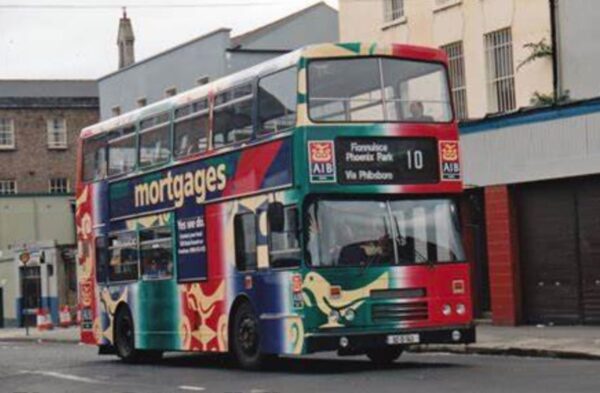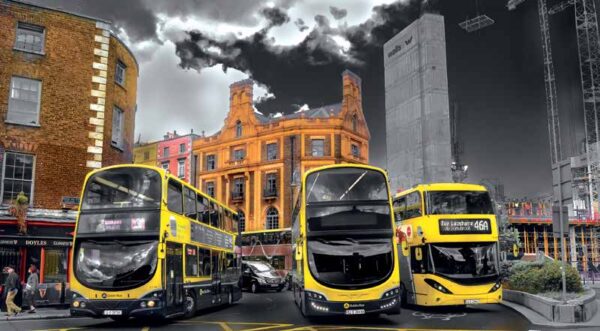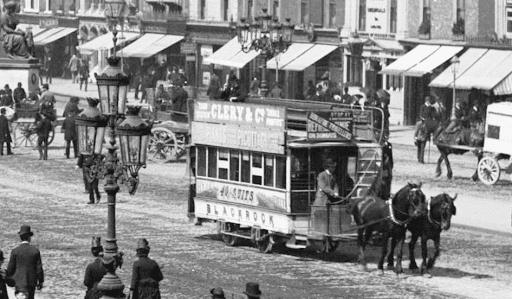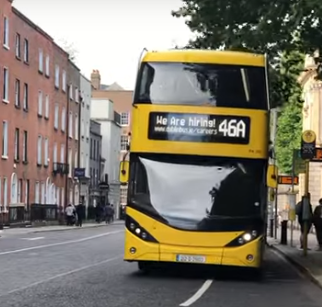
The upgrade of bus networks has resulted in significant rerouting. Bus numbers, once a feature of everyday life, have disappeared. Donnybrook users might remember the number 10 which once carried them across the city, as well as countless family trips to Dublin Zoo. Such excursions endeared this bus to the people, and its end was sadly mourned in 2010. Our relationship with this number offers some indication of the love we have for our public transport.
No less our beloved 46A, which was a feature of Dublin life for nearly ninety years. Its journey, from the Phoenix Park to Dun Laoghaire is said to have taken one hour and 37 minutes in total. It carried so many Dubliners on so many occasions, it was bound to acquire a special place in our hearts, and not least its Donnybrook users, who had become accustomed to it passing Morehampton Road or Donnybrook Church.
News of it becoming obsolete featured in print, television and radio. Media attention highlighted some past users’ cherished memories, and there was much disgruntlement about the withdrawal. Some people made emotional pleas to preserve, in particular, its number, while others emphasised its potential as a tourist attraction. The 46A was no stranger to admiration, having been immortalised in popular culture by the band Bagatelle. Nevertheless, on January 25 at 11:30pm it made its last journey. This brought people out on the streets to observe, one last time, their much-lamented bus.
For policy makers such changes are observed to be but a phase in what is an ever-evolving public transport system. There is much to regret about the 46A being discontinued. Though, it is but one casualty of the National Transport Authority’s (NTA) strategy to facilitate a more effective system.

From Tram to Bus: The Evolution of our Transport System
To put this into perspective, a step back in transport history is needed. The first trams, which were horse-drawn, revolutionised public transport. Some early routes included College Green to Rathgar, and Nelson’s Pillar to Sandymount via Bath Avenue (1782). The Donnybrook line was opened in 1783 (Donnybrook bus garage was once the Tram depot).
The year 1880 marked the appearance in Russia of the first fully electric tram. The electrification of Dublin’s tram system was underway by the 1890s. Shortly, the Dublin United Tramways (an amalgamation of a number of tram companies) had embarked on a more extensive and therefore a more effective system of public transport. A casualty of electrification as well as modernisation was the horse-drawn tram, which made its last journey in January of 1901. A sight much lamented by some Dubliners.
The Bus – rival or replacement.

By the 1930s the tram system was being supplemented by buses, the first official bus route opened in 1925. In this period, car ownership was increasing, and many roads were either being upgraded or extended. The bus was soon being touted as competition, and in some cases as superior to the tram. In 1936 the 46A went into service (it followed nearly the same route until it was decommissioned). By the end of that decade the mobility of bus services like the 46A made any insertion of new trams appear unlikely. It is of interest to note that the final tram from Dublin to Donnybrook, ‘the No. 9’ left the city in 1940.
Yet, the demise of the tram was not solely down to an increase in car ownership or new bus extensions. While buses were more mobile and had the ability to reach long distances, which was certainly a feature of tram decline. There was also the argument, which persuaded the city authorities, that the tram system was beginning to lead to traffic gridlocks (this would later be proved unfounded). Subsequently, there were also energy concerns during WW2, and Sean Lemass noted at a Dáil Éireann meeting in 1942 that, “those trams still in service are at the present time consuming a quantity of electricity which is causing us great concern, so much concern that restrictions upon the hours of operation of those trams will almost inevitably have to be imposed in the very near future.” Whatever the case, the last Dublin tram made its final journey in 1949, with the Howth Head line lasting a further ten years.
The Problems of Public Transport Endured
Nonetheless, transport deficiencies continued. Commenting on the Transport Bill of 1964 former Lord Mayor of Dublin and Ballsbridge native Maurice Dockrell remarked, “I can remember the days of the trams and, while I do not necessarily want to see the trams back again, I never saw in those days, queues 30 or 40 yards long at 5.30 in the evening in the centre of the city as I see every evening now.” Many of us who use public transport in 2025 can attest to a similar situation. In fact, the traffic congestion has gotten worse, and there is a population increase, which has further stressed an already pressured system.
The Introduction of the E2
This is where the contentious removal of the 46A slots into the history of transportation. It is but one of a number of noteworthy changes which the NTA believe will relieve pressure on the system. The successor to the 46A is the E2, a round-the-clock service. This adjustment is consistent with the Government’s Night-Time Economy Task Force’s recommendations. To improve the public realm, and provide effective public transport solutions at night, serving the shift worker, the party goer/ and the night-time economy.

The combined E-spine routes, E1 and E2, endeavour to make transport more connected. The E-spine, though it is not to everyone’s liking, does provide access to key services. They include a number of third-level colleges, and hospitals. It is said that such routes will prove more reliable for users.
Underground: The Best Solution
Another solution to the many problems faced by Dublin commuters would be an extensive underground metro system. A good example of how this has been achieved today can be found in Greece. Like Ireland this country suffered a collapse and had almost gone broke on three occasions. Yet, it has slowly recovered, in contrast to Ireland, which has the fastest growing economy in the Eurozone. Nonetheless, Greece has prioritised high-quality transportation and in particular the modern underground system in the city of Thessaloniki. This city is set to reap the rewards of a service that is estimated to cater to 250,000 passengers a day, in a city of more than one million people.

This significantly improves the city’s transportation infrastructure, reduces traffic congestion, and air pollution. It will also boost the economy by attracting more tourists and facilitating easier access to various parts of the city. Greek officials note that the line will mean 57,000 fewer cars per day in this traffic-choked city. The underground will also double as a museum, with passengers arriving at the city centre Eleftherios Venizelos station viewing more than 300,000 artifacts dug up by archaeologists. Five extra stations are soon to be added, ultimately linking the city centre to the airport. With Dublin Metro Link, connecting central Dublin with Swords and the Airport said to break ground in 2026, let’s hope that Dublin continues to update and modernise our transport system.
Yet, as the English novelist Mary Wollstonecraft Shelley once said, “nothing is so painful to the human mind as a great and sudden change.” And, as we have seen, change is inevitable. Yet we can take pleasure in that the 46A did not simply disappear, without leaving a trace. It left us with stories and memories which attest to its emotional importance. So, Farewell! to the 46A – you played a pivotal role in city life, and will always have a special place in our hearts.



